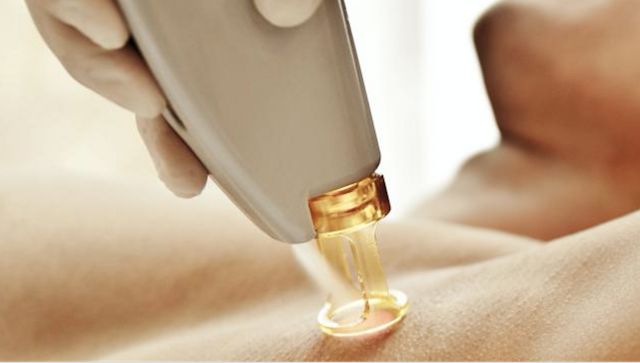HAIR REMOVAL-SALON TREATMENTS
Welcome to the reality of unwanted body hair. Like natal females, we visit a salon to shape our eyebrows, and rip off our leg, armpit, and vaginal hair. Unlike our natal sisters, we tran sfemales have the additional joys of removing testosterone stimulated facial hair and chest hair. A vestige from male puberty that is not reversible with hormones. Shaving is a daily ritual that is a reminder of our male hereditary. Waxing…er, no. Neither are permanent, anyway, so we must resort to alternative salon options, being either electrolysis or laser.
sfemales have the additional joys of removing testosterone stimulated facial hair and chest hair. A vestige from male puberty that is not reversible with hormones. Shaving is a daily ritual that is a reminder of our male hereditary. Waxing…er, no. Neither are permanent, anyway, so we must resort to alternative salon options, being either electrolysis or laser.
Hair has little remaining physiologic importance, but great psychological importance
Beauty does have its price, girls. Hair removal is a lengthy, uncomfortable and costly process. There are over 5 million hair follicles on the human body, with the concentration(about 1 million) being on the scalp. Hair has little remaining physiologic importance, but great psychological importance. The two principle salon processes of permanent hair removal are electrolysis and laser. Each technique attacks the hair follicle in very different ways.
Hair growth happens in cycles, therefore, any method will take multiple treatments over the course of several months, possibly up to several years, to complete. Reason being, all the hairs in a specific area are not in the active phase simultaneously. The hair growth cycle has four phases:
- Anagen: the active phase of hair growth. Determines the final length of the hair.
- Catalan: the transitional phase. This lasts for about ten days and where the follicle detaches from the dermal papilla.
- Telogen: the resting phase and lasts about three months. In this phase, the old hair ceases growth and new hair begins the regrowth process.
- Exogen: the continuation of the resting phase. Old hair sheds and new hair pushes out the old hair. Also referred to as the “Return to Anagen” phase.
Hair is actually dead protein. Color, length and coarseness vary, depending on the location on the body. For instance, fine hair on the upper cheeks and forearms differs from the mop on your head and from unwanted, coarse, facial hair. Three are two important factors in a successful completion of permanent hair removal. Your skin tone and hair type.
The father of modern academic dermatology
SKIN TONE
Thomas Fitzpatrick, an American dermatologist, known as the “father of modern academic dermatology” studied hundreds of people, principally for treatments of skin cancers, and how the skin reacted to UV light. He developed a scale of skin types, known as the “Fitzpatrick Scale,” which helped increase the effectiveness of the cancer treatments. Since laser treatments hit the skin with UV light, laser machines and technicians use the Fitzpatrick scale to determine how best to treat patients.
HAIR TYPE
Determining your hair type is just as crucial for successful treatment. There are three types of hair on the human body:
- Lanugo: This is the very fine hair we first had in gestation. It protects delicate skin and is typically very light in color
- Vellus: This is the ‘peach fuzz’ covering mostly children and cis-women. It acts as wick to pull sweat from the skin, which is most likely an ingredient to why women are more susceptible to colder temps.
- Terminal: Longer, thicker, and darker than villus hair. It varies in length, making up the hair on arms, head, face, legs, genitals.
Your hair shape is typically relegated to head and genital hair. There are four shapes of hair on the human body: Straight, Wavy, Curly, Kinky. Shape is determined on the shape of the hair follicle. The more hooked the hair bulb, the curlier the hair.
Electrolysis v Laser
Electrolysis penetrates the hair follicle directly, and is recognized by the FDA and the AMA as the only permanent method of hair removal. There are three distinct types of electrolysis:
- Galvanic: This type of electrolysis works through a chemical reaction. The probe administers an electric pulse, which reacts with the saline of the hair follicle, creating Sodium Hydroxide(lye). This process destroys the cells around the follicle, and continues working for a time after the probe is removed. The probe must stay inserted for unto 3 minutes per hair, therefore, is best suited for course hair.
- Thermolysis: This type uses a radio frequency, at a high frequency. The probe transmits the radio current, which vibrates the hair follicle. This generates heat, which in turn disrupts the target cells, turning the water into a fluid mass, destroying the hair follicle. The probe can stay inserted for a few seconds, and is quicker than the Galvanic method. This treatment is most effective on fine hair.
- Blend: As the name suggests, it is a combination of the Galvanic and Thermolysis methods. Sodium Hydroxide produced by the galvanic process is heated up at the high frequency of the thermolysis method, increasing the strength of the Sodium Hydroxide. The lye is dispersed into every area of the hair follicle. This method is faster than straight galvanic, but a bit slower than straight thermolysis. This is best suited for facial hair or the sporadic coarse hair.
What to expect:
Treatment effectiveness: 100% effective on all hair types, regardless of color or ethnicity.
Side effects: skin redness or scabbing are typical side effects and are usually not permanent. There are many variables involved, so it is vital you discuss all your concerns with your technician.
There are varying levels of discomfort. Most patients report a tingling sensation, while others feel more intense pain.. Topical anesthetic creams, such as lidocaine, may be used in some cases to ameliorate the sensations.
Electrolysis works on ALL hair types. Since the probe, the needle, penetrates straight to the follicle, directly administering the electric pulse to the kill the hair bulb. This treatment works in all of the first three phases of hair growth, where as laser treatment does not.
The drawbacks to this service is that results will take many treatments and therefore gets expensive. Also, if you have been tweezing pesky hairs, this changes the hair shaft. This may also stimulate the hair to re-grow coarser and stronger, adding a level of difficulty to the depilation process.
 Laser treatments are only effective in the anagen phase of hair growth. It is necessary to determine what type of skin and hair you are for the best possible results. There are four common types of laser machines:
Laser treatments are only effective in the anagen phase of hair growth. It is necessary to determine what type of skin and hair you are for the best possible results. There are four common types of laser machines:
- Ruby: Oldest of the laser machines in use. Effective on fine hair, but more likely to skin discoloration. Used most on people with light skin, who’s pigment is less susceptible to discoloration.
- Alexandrite: Has a bigger spot size for a wider treatable area. Effective on most skin tone, including olive skin pigmentation. All skin tones, but light skin, are susceptible to discoloration and burns.
- Diode: Of the newest machines on the market. Effective on fair to medium skin types. Longer laser wavelengths mean it is less susceptible to discoloring or burning skin.
- Nd:YAG: Penetrates deeper than the previous three. It is the preferred machine for darker skin tones. Has a weaker laser light, and will take multiple passes to be fully effective. It is more painful and not effective on fine hair.
Most patients have laser treatments during the winter months. It is not recommended to undertake laser treatments less than six weeks after sun exposure. This promotes permanent scarring and discoloration.
The process is painful and irritating. Fortunately, most treatments are completed over the course of 4-6 sessions. Darker skin tone and lighter hair type will lengthen this process.
Intense Pulsed Light(IPL) is not a true laser machine and shouldn’t be promoted as such. It is a full spectrum of pulsed light, with varying filters attached to focus the required wavelengths of light to treat light blood vessels and dark spots or aging spots. Is used for hair removal but is not very effective and will take scores of treatments to remove hair.
What to expect:
Treatment effectiveness: Will not work on light, gray and red hairs. Effective on light and coarse hairs.
Side effects: Include pigment discoloration and scarring. Skin redness will occur immediately following treatments. Redness will dissipate over the course of a couple hours.
Finding a trans-friendly salon and technician that fits your needs can be a challenge. Most salons do not have an issue with treating transgender females. They may have restrictions on which areas of the body they are comfortable treating. For instance, some may not work around the genital area, or on a chest.
Best recommendation is word-of-mouth referral. Failing that, cold calls or emails work just as well. You can explain your situation, and get a feel for each other before stepping into their salon. Before starting any treatment, you will fill out a consent form. At the time of initial consultation, it is customary to have a 15-minute trial session.
It is important to do your research and be well informed before consulting a technician. This person will be in your life for months and years, depending on your needs. Ask questions. Better to bare a little embarrassment, than to assume one thing and be disappointed at the result.
As with any medical treatment, there may be negative effects on the skin. This is dependent on your skin type and hair type. Reiterating, risks include dark spots, scabbing, skin ‘pits or divots’, discoloration, or scarring may result. These are, in most cases, temporary, but can be permanent. It is strongly recommended to have a trial area done before starting any full fledged treatment. Any reputable salon will recommend this, and if they happen not to, should accommodate this request.
We still have to bridge the time between salon visits with non-permanent hair removal solutions. Check out the associated home depilation options article, for home grooming alternatives and advice.
Additional Electrolysis information: Additional Laser information:
mir, irini, peace, amn,
-jahn



































